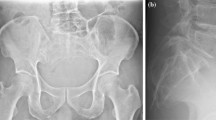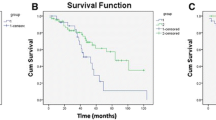Abstract
Background: The natural history of chordoma is characterized by a high failure rate and a poor functional outcome. The purpose of this study was to review the long-term outcome of our institutional experience.
Methods: The clinical features, type of treatment, pathologic assessment, and follow-up of 56 consecutive patients with chordoma were reviewed.
Results: Fifty sacral and six mobile spine chordomas (median size, 13 cm; range, 2–30 cm) were treated at our center between January 1933 and December 2000. Twenty-eight patients affected by sacrococcygeal chordoma and operated on after 1977 form the basis of our study. Surgical margins were rated as wide in 11 cases, marginal in 13 cases, and intralesional in 4 cases. The median follow-up was 71 months (range, 15–200 months). Seventeen patients’ disease recurred. Ten patients died as a result of disease. Nine patients remained continuously free of disease. The estimated 5- and 10-year overall survival was, respectively, 87.8% and 48.9%; disease-free survival was 60.6% and 24.2%. Radiotherapy was considered for marginal and intralesional resections.
Conclusions: High sacral amputation can achieve a good rate of wide-margin resections for sacrococcygeal chordomas. Adjuvant radiotherapy may offset the negative effect in the prognosis of marginal resections.
Similar content being viewed by others
REFERENCES
Heaton JM, Turner PR. Reflections on notochordal differentiation arising from a study of chordoma. Histopathology 1980; 9: 543–50.
Eriksson B, Gunterberg B, Kindblom LG. Chordoma. A clinicopathologic and prognostic study of a Swedish national series. Acta Orthop Scand 1981; 52: 49–58.
Dorfmann HD, Czerniak B. Chordoma and related lesions. In: Bone Tumors. St. Louis: Mosby, 1998: 974–1007.
Dahlin DC, McCarty LS. Chordoma: a study of 59 cases. Cancer 1952; 5: 1170–8.
Sundaresan N, Huvos AG, Krol G, Lane JM, Brennan M. Surgical treatment of spinal chordomas. Arch Surg 1987; 122: 1479–82.
Samson IR, Springfield DS, Suit HD, Mankin HJ. Operative treatment of sacrococcygeal chordoma. A review of twenty-one cases. J Bone Joint Surg Am 1993; 75: 1476–84.
Yonemoto T, Tatezaki S, Takenouchi T, Ishii T, Satoh T, Moriya H. The surgical management of sacrococcygeal chordoma. Cancer 1999; 85: 878–83.
York JE, Kaczaraj A, Abi-Said D, et al. Sacral chordoma: 40-year experience at a major cancer center. Neurosurgery 1999; 44: 74–80.
Ozaki T, Hillmann A, Winkelmann W. Surgical treatment of sacro-coccygeal chordoma. J Surg Oncol 1997; 64: 274–9.
Stephens CG, Schwartz HS. Lumbosacral chordoma resection: image integration and surgical planning. J Surg Oncol 1993; 54: 226–32.
Mindell ER. Current concepts review. Chordoma. J Bone Joint Surg Am 1981; 63: 501–5.
Ozdemir MH, Gurkan I, Yildiz Y, Yilmaz C, Saglik Y. Surgical treatment of malignant tumor of the sacrum. Eur J Surg Oncol 1999; 25: 44–9.
Chandawarkar RY. Sacrococcygeal chordoma: review of 50 consecutive patients. World J Surg 1996; 20: 717–9.
Anson KM, Byrne PO, Robertson DI, Gullan RW, Montgomery ACV. Radical excision of sacrococcygeal tumours. Br J Surg 1994; 81: 460–1.
Salvini E, Zucali R. Considerazioni su 15 casi di cordoma. Chir Organi Mov 1965; 54: 295–306.
Azzarelli A, Quagliolo V, Cerasoli S, et al. Chordoma. Natural history and treatment. Results in 33 cases. J Surg Oncol 1988; 37: 185–91.
Enneking WF, Spanier SS, Goodman MA. A system for the surgical staging of the musculoskeletal sarcoma. Clin Orthop 1980; 153: 106–20.
Stener B, Gunterberg B. High amputation of the sacrum for extirpation of tumors: principles and technique. Spine 1978; 3: 351–8.
Gennari L, Azzarelli A, Quagliolo V. A posterior approach for the excision of sacral chordoma. J Bone Joint Surg Br 1987; 69: 565–8.
Xu WP, Song XW, Yue SY, Cai YB, Wu J. Primary sacral tumors and their surgical treatment. A report of 87 cases. Clin Med J 1990; 103: 879–94.
Sundaresan N. Chordomas. Clin Orthop 1986; 204: 135–42.
Sung HV, Shu WP, Wang HM, Yuai SY, Tsai YB. Surgical treatment of primary tumors of the sacrum. Clin Orthop 1987; 215: 91–8.
Bethke KP, Neifeld JP, Lawrence W Jr. Diagnosis and management of sacrococcygeal chordoma. J Surg Oncol 1991; 48: 232–8.
Dahlin DC, MacCarthy CS. Chordoma: a study of 59 cases. Cancer 1952; 5: 1170–8.
Kaiser TE, Pritchard DJ, Unni KK. Clinicopathologic study of sacrococcygeal chordoma. Cancer 1984; 54: 2574–8.
Cheng EY, Ozerdemoglu RA, Transfeldt EE, Thompson RC. Lumbosacral chordoma. Prognostic factors and treatment. Spine 1999; 24: 1639–45.
Conlon KC, Boland PJ. Laparoscopically assisted radical sacrococcygectomy. A new operative approach to large sacrococcygeal chordomas. Surg Endosc 1997; 11: 1118–22.
Bergh P, Kindblom LG, Gunterberg B, Remotti F, Ryd W, Meis-Kindblom JM. Prognostic factors in chordoma of the sacrum and mobile spine. Cancer 2000; 88: 2122–34.
Breteu N, Demasure M, Favre A, et al. Fast neutron therapy for inoperable or recurrent sacrococcygeal chordoma. Bull Cancer Radiother 1996; 83: 142S–145S.
Catton C, O’Sullivan B, Bell R, et al. Chordoma: long-term follow-up after radical photon irradiation. Radiother Oncol 1996; 41: 67–72.
Magrini SM, Papi MG, Marletta F, et al. Chordoma natural history, treatment and prognosis. The Florence radiotherapy department experience (1956–1990) and a critical review of the literature. Acta Oncol 1992; 31: 847–51.
Bjornsson J, Wold LE, Ebersold MJ, Laws ER. Chordoma of the mobile spine. A clinicopathologic analysis of 40 patients. Cancer 1993; 71: 735–40.
Thieblemont C, Biron P, Rocher F, et al. Prognostic factors in chordoma: role of post-operative radiotherapy. Eur J Cancer 1995; 31A: 2255–9.
Gunterberg B, Norlen L, Stener B, Sundin T. Neurologic evaluation after resection of the sacrum. Invest Urol 1975; 13: 183–8.
Author information
Authors and Affiliations
Rights and permissions
About this article
Cite this article
Baratti, D., Gronchi, A., Pennacchioli, E. et al. Chordoma: Natural History and Results in 28 Patients Treated at a Single Institution. Ann Surg Oncol 10, 291–296 (2003). https://doi.org/10.1245/ASO.2003.06.002
Received:
Accepted:
Issue Date:
DOI: https://doi.org/10.1245/ASO.2003.06.002




